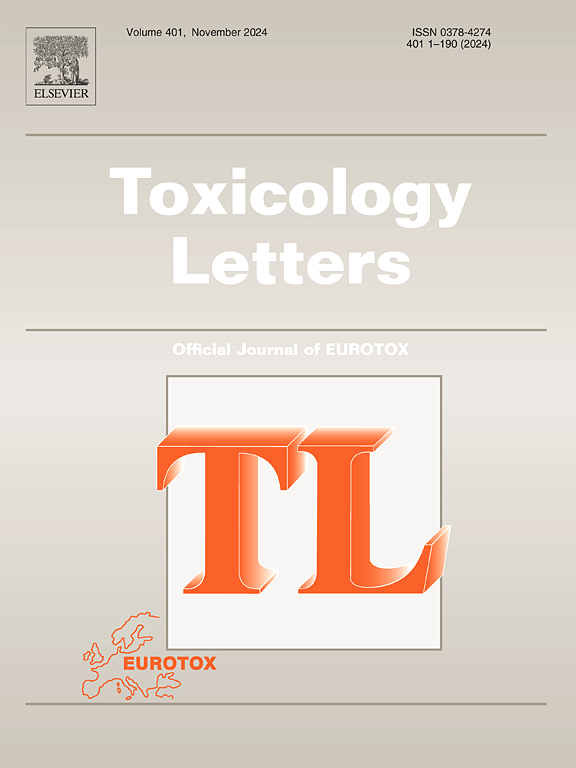Toxicological mode-of-action and developmental toxicity of different carbon chain length PFAS
IF 2.9
3区 医学
Q2 TOXICOLOGY
引用次数: 0
Abstract
Per-and polyfluoro alkyl substances (PFAS), also known as “forever chemicals”, are deemed as highly toxic with similar toxicological mode-of-action (MoA) and potency. However, varying carbon chain length and functional head-group of PFAS can affect their physicochemical properties, resulting in different toxicological properties. To assess PFAS toxicological MoA and to distinguish between high toxic PFAS and the low-toxic analogs, we tested a set of eight PFAS with varying carbon chain length (C2-C10) in the ToxProfiler assay. ToxProfiler is a human in vitro assay containing seven fluorescent reporters to visualize and quantify activation of the major cellular stress pathways: oxidative stress, cell cycle stress, endoplasmic reticulum (ER) stress, autophagy, ion stress, protein stress and inflammation. In addition, we evaluated teratogenicity potential of long-chain PFAS perfluorooctanoic acid (PFOA; C8), and the ultrashort-chain PFAS trifluoroacetic acid (TFA; C2) in ReproTracker, a human induced pluripotent stem cell (hiPSCs)-based assay in which differentiation into cardiomyocytes, hepatocytes, and neural rosettes is followed to identify developmental toxicity hazards of new drugs and chemicals. In this study, we identified long-chain PFAS (C8-C10), such as PFOA (C8) to be more cytotoxic than ultrashort-chain PFAS and to predominantly induce ER and oxidative stress at 130 µM. PFAS with a carbon chain length of C4-C7 primarily induced autophagy (300 µM) in ToxProfiler. Ultrashort-chain PFAS trifluoroacetic acid (TFA; C2) and perfluoropropionic acid (PFPrA; C3) did not activate any of the ToxProfiler stress response reporters and were not cytotoxic at their maximum tested concentrations (10 mM). In concordance, exposure of differentiating cells to PFOA in ReproTracker led to a concentration-dependent decrease in the hepatocyte-specific and neuroectodermal biomarker genes and disrupted their morphology at 30 and 60 µM, respectively. TFA had no significant effect on biomarker expression, nor on the morphology/functionality of the three differentiated cells. Altogether, we demonstrated that the carbon chain length of PFAS can determine their in vitro toxicity and ultrashort-chain PFAS (TFA) were found to be less toxic when compared to long-chain PFAS.
不同碳链长度PFAS的毒理学作用方式及发育毒性。
全氟和多氟烷基物质(PFAS)也被称为“永远的化学品”,被视为具有类似毒理学作用方式和效力的剧毒物质。然而,不同的碳链长度和官能团的PFAS会影响其物理化学性质,从而导致不同的毒理学性质。为了评估PFAS毒理学MoA并区分高毒性PFAS和低毒类似物,我们在ToxProfiler试验中测试了8组不同碳链长度(C2-C10)的PFAS。ToxProfiler是一种人体体外检测方法,包含7种荧光报告,用于可视化和量化主要细胞应激途径的激活:氧化应激、细胞周期应激、内质网(ER)应激、自噬、离子应激、蛋白应激和炎症。此外,我们还评估了长链全氟辛烷酸(PFOA;C8)和超短链PFAS三氟乙酸(TFA;retracker是一项基于人类诱导多能干细胞(hipsc)的实验,该实验通过向心肌细胞、肝细胞和神经玫瑰花组织的分化来识别新药和化学品的发育毒性危害。在本研究中,我们发现长链PFAS (C8- c10),如PFOA (C8)比超短链PFAS具有更强的细胞毒性,并且在130µM时主要诱导内质网和氧化应激。在ToxProfiler中,碳链长度为C4-C7的PFAS主要诱导自噬(300µM)。超短链PFAS三氟乙酸;C2)和全氟丙酸(PFPrA;C3)没有激活任何ToxProfiler应激反应报告细胞,并且在其最大测试浓度(10mM)下没有细胞毒性。与此一致的是,在retracker中,分化细胞暴露于PFOA会导致肝细胞特异性和神经外胚层生物标志物基因的浓度依赖性降低,并分别在30和60µM时破坏它们的形态。TFA对生物标志物的表达没有显著影响,对三种分化细胞的形态/功能也没有显著影响。总之,我们证明了PFAS的碳链长度可以决定其体外毒性,并且发现超短链PFAS (TFA)与长链PFAS相比毒性更小。
本文章由计算机程序翻译,如有差异,请以英文原文为准。
求助全文
约1分钟内获得全文
求助全文
来源期刊

Toxicology letters
医学-毒理学
CiteScore
7.10
自引率
2.90%
发文量
897
审稿时长
33 days
期刊介绍:
An international journal for the rapid publication of novel reports on a range of aspects of toxicology, especially mechanisms of toxicity.
 求助内容:
求助内容: 应助结果提醒方式:
应助结果提醒方式:


